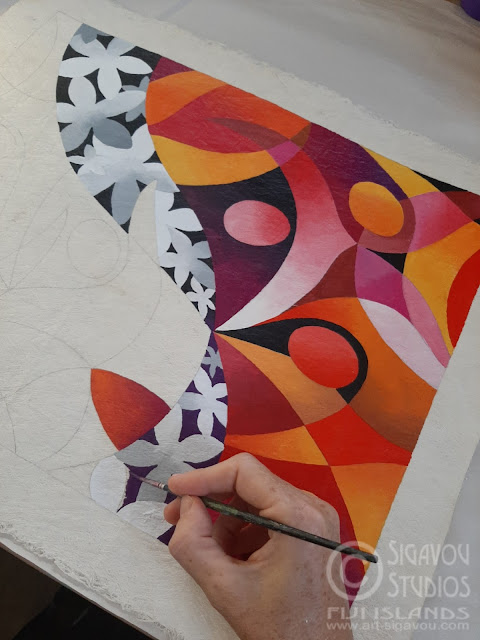Creativity and burnout are not a constructive combination. My solution, when stress takes over and the brain fog rolls in, is to escape into nature, preferably to a deserted beach with some good snorkeling close at hand! Soaked in saltwater, I hover over coral reefs bursting with texture and colour. A sense of wonder inevitably takes over, and gratitude fills my soul: how awesome is it to be able to call the Pacific Ocean my home!
It was on one such island escape that the inspiration for "High Tide VI" came floating by. I was snorkeling along a windy passage between two Yasawa Islands, when something white bobbed into my peripheral vision close at hand: a perfect nautilus shell! (See photo above.) Long empty by the look of it's weathered surface, it was buoyed along by the waves, air trapped inside the architecture of its spiral form. I had drawn these magnificent shells many times before, but this was a first: finding one that wasn't cracked or broken! Really, I should say, it found me! A moment of serendipity worth celebrating with a piece of art...
Using a derelict boat as a makeshift studio, I created the concept for "High Tide VI". I'd forgotten to bring a palette, so a few seashells came in handy when it came to mixing my paints!.
In step with other paintings in my evolving "High Tide" series, I added local flowers for contrast and colour. These are the blossoms of the Rangoon Creeper, known locally 'Kakala'. They festoon our neighbour's fence, ranging in colour from cheerful vermilion to delicate pink.
Here's a shot of the end result, painted in acrylics on barkcloth-covered board:
And here are members of our studio team, celebrating the completion of my "High Tide" series, which can now be seen on the walls of guestrooms at the Radisson Blu Resort on Denarau Island:
All thanks to a chance encounter with an empty nautilus shell, floating across the ocean....
By the way, my daughters have talked me into starting an Instagram account for Sigavou Studios! Please cheer us on here SIGAVOU ON INSTAGRAM ! Vinaka!






















































